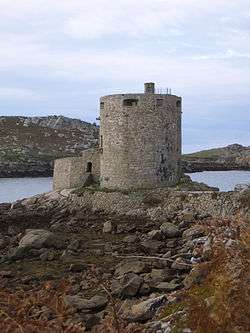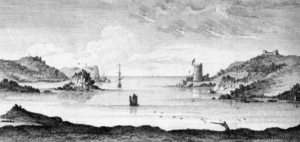Cromwell's Castle
Cromwell's Castle is an artillery fort overlooking New Grimsby harbour on the island of Tresco in the Isles of Scilly. It comprises a tall, circular gun tower and an adjacent gun platform, and was designed to prevent enemy naval vessels from entering the harbour. The castle was built in two phases; Sir Robert Blake constructed the tower between 1651 and 1652 in the aftermath of the Parliamentary invasion of the islands at the end of the English Civil War, and Master Gunner Abraham Tovey added the gun platform during the War of Jenkins' Ear around 1739. The tower fell into disuse soon afterwards, and in the 21st century is managed by English Heritage and open to visitors.
| Cromwell Castle | |
|---|---|
| Tresco in the Isles of Scilly | |
 The castle, seen from the land | |
 Cromwell Castle | |
| Coordinates | 49.9616°N 6.3505°W |
| Grid reference | grid reference SV881159 |
| Type | Artillery tower |
| Height | 15.1 metres (50 ft) |
| Site information | |
| Controlled by | English Heritage |
| Site history | |
| Materials | Stone rubble |
History
17th century
Cromwell's Castle is an artillery tower, built by Sir Robert Blake following the Parliamentary invasion of the Isles of Scilly in 1651.[1] During the English Civil War between 1642 and 1646, the inhabitants of the Isles had been Royalist supporters of King Charles I, and rebelled against Parliament in favour of Charles in 1648.[1] Tresco became a base for Royalist privateers and Parliament became concerned that the Dutch, then hostile to England, might exploit the situation, or that Royalist Irish forces might use the islands for an attack on England.[2] In 1651 Parliament sent Robert Blake and a naval force to retake the island, which had been fortified by the Royalists.[3]

Having established control of the islands, between 1651 and 1652 Blake constructed Cromwell's Castle on Tresco, named after Oliver Cromwell, the Parliamentary leader.[4] It was intended to protect the deep water entrance to New Grimsby harbour on the west side of the island, a route which could also allow enemy vessels access through to the other Scilly Isles.[5] The Parliamentarian forces were particularly concerned about any potential Dutch attack.[6]
There were two existing fortifications in this location.[7] The main existing fort, King Charles's Castle, had been built in the 1550s but was poorly sited and had been blown up by its defenders when Blake's forces took the island.[8] There was also a small blockhouse beneath it, dating from the 16th century, and the new castle was built on top of this preexisting site.[9]
The castle initially comprised a three-storey circular tower, 13.45 metres (44.1 ft) across and 15.1 metres (50 ft) high, with walls almost 13 feet (4.0 m) thick, made from massive pieces of rubble; a later survey described the tower as "a Huge Mass of Masonry".[10] Some of the stone used came from the ruins of King Charles's Castle.[11] Six gun-ports with broad external splays on the roof allowed the battery a good angle of fire across the channel between the islands of Bryher and Tresco.[12] There may have been an adjacent gun platform just beneath the main structure.[9] The design was old-fashioned, resembling the circular keeps built by Henry VIII in the mid-16th century.[13]
17th–20th centuries

After the restoration of Charles II to the throne in 1660, a survey of the castle was carried out, which recommended repairs to the site.[14] A survey carried out at the end of the 1730s suggested that the castle had ten artillery positions, but that there were not enough guns on the island to arm both the castle and the other defences, and that some of the guns that were available were unusable.[15]
In 1739, the War of Jenkins' Ear broke out between Britain and Spain, and the decision was taken to improve the defences at Cromwell Castle.[16] Abraham Tovey, the Master Gunner at the nearby fortification known as the Garrison, constructed a large gun-platform for a battery of six guns on the south-west side of the tower, possibly on top of any pre-existing 16th-century platform.[17] A parapet protected the guns, a new entrance was cut into the main tower and other adjustments made.[18]
The antiquary William Borlase visited the castle in 1752, noting that the gun platform was armed with 9-pounder (4 kg) cannons and the tower roof with 4-pounder (1.8 kg) guns.[19] The site was now unmanned, however, and had fallen into decay since the construction work by Tovey.[19] The writer John Troutbeck, commenting at the end of the century, remarked on the tower having a "special bomb proof" roof, topped with 6-foot (1.8 m) high parapets.[20] He noted, that although there while still some old iron artillery guns present, the site was still ungarrisoned and in a state of disrepair.[20]
The Crown, in the form of the Duchy of Cornwall, had leased the Scilly Isles to the Godolphin family in 1687, followed by Augustus Smith in 1834.[21] In 1922, the lease passed to Arthur Dorrien-Smith, who agreed to pass several properties on Tresco, including the castle, into the guardianship of the Ministry of Works.[22]
21st century

In the 21st century, the castle is controlled by English Heritage, as the successor to the Ministry of Works, and open to visitors. The interior wooden floors have been lost, but the spiral staircase and the stone, vaulted roof remain intact and accessible.[23] English Heritage have commented that the castle is "one of only a few stone fortifications that survive from the Interregnum", and it is protected by UK law as a Grade II* listed building.[24]
See also
References
- Bowden & Brodie 2011a, p. 9
- Bowden & Brodie 2011b, p. 20
- Bowden & Brodie 2011a, p. 9; Bowden & Brodie 2011b, p. 20
- O'Neil 1961, p. 25
- "History of Cromwell's Castle", English Heritage, archived from the original on 27 August 2016, retrieved 23 August 2016
- Saunders 1989, p. 82
- Bowden & Brodie 2011a, p. 9; Bowden & Brodie 2011b, p. 29
- Bowden & Brodie 2011a, p. 9; "History of Cromwell's Castle", English Heritage, archived from the original on 27 August 2016, retrieved 23 August 2016
- Bowden & Brodie 2011b, p. 29
- O'Neil 1961, p. 25; Brodie 2010, p. 30; "Cromwell's Castle: Mid-17th Century Blockhouse and 18th Century Gun Platform on the Western Coast of Castle Down, Tresco", Historic England, archived from the original on 26 August 2016, retrieved 23 August 2016; "History of Cromwell's Castle", English Heritage, archived from the original on 27 August 2016, retrieved 23 August 2016
- "History of Cromwell's Castle", English Heritage, archived from the original on 27 August 2016, retrieved 23 August 2016; "King Charles Castle", Historic England, archived from the original on 15 September 2016, retrieved 1 September 2016
- O'Neil 1961, p. 25; "Cromwell's Castle: Mid-17th Century Blockhouse and 18th Century Gun Platform on the Western Coast of Castle Down, Tresco", Historic England, archived from the original on 26 August 2016, retrieved 23 August 2016; "History of Cromwell's Castle", English Heritage, archived from the original on 27 August 2016, retrieved 23 August 2016
- Brodie 2010, p. 30; Bowden & Brodie 2011b, pp. 27, 29
- Bowden & Brodie 2011b, pp. 29–30
- Brodie 2011, p. 4
- Bowden & Brodie 2011a, p. 10
- O'Neil 1961, p. 25 for Tovey
- O'Neil 1961, pp. 25–26
- Borlase 1756, pp. 47–48; "Cromwell's Castle: Mid-17th Century Blockhouse and 18th Century Gun Platform on the Western Coast of Castle Down, Tresco", Historic England, archived from the original on 26 August 2016, retrieved 23 August 2016
- Troutbeck 1796, p. 126
- "Obituary - Major Dorrien-Smith", The Times, archived from the original on 28 March 2014, retrieved 29 January 2014
- O'Neil 1961, p. 3; "Obituary - Major Dorrien-Smith", The Times, archived from the original on 28 March 2014, retrieved 22 August 2016
- "Cromwell's Castle: Mid-17th Century Blockhouse and 18th Century Gun Platform on the Western Coast of Castle Down, Tresco", Historic England, archived from the original on 26 August 2016, retrieved 23 August 2016
- "Cromwell's Castle: Mid-17th Century Blockhouse and 18th Century Gun Platform on the Western Coast of Castle Down, Tresco", Historic England, archived from the original on 26 August 2016, retrieved 23 August 2016; "History of Cromwell's Castle", English Heritage, archived from the original on 27 August 2016, retrieved 23 August 2016
Bibliography
- Borlase, William (1756). Observations on the Ancient and Present State of the Islands of Scilly, and Their Importance to the Trade of Great Britain. Oxford, UK: W. Jackson. OCLC 64415301.CS1 maint: ref=harv (link)
- Brodie, Allan (2010). "The Tudor Defences of Scilly". English Heritage Historical Review. 5: 24–43.CS1 maint: ref=harv (link)
- Brodie, Allan (2011). The Garrison, St Mary's, Isles of Scilly: The Defences of the Garrison 1500–1945, Survey Report. London, UK: English Heritage. ISSN 1749-8775.CS1 maint: ref=harv (link)
- Bowden, Mark; Brodie, Allan (2011a). "Defending Scilly". Research News. 16: 8–11.CS1 maint: ref=harv (link)
- Bowden, Mark; Brodie, Allan (2011b). Defending Scilly. London, UK: English Heritage. ISBN 9781848020436.CS1 maint: ref=harv (link)
- O'Neil, B. H. St John (1961). Ancient Monuments of the Isles of Scilly (2nd ed.). London, UK: Her Majesty's Stationery Office. OCLC 58256.CS1 maint: ref=harv (link)
- Saunders, Andrew (1989). Fortress Britain: Artillery Fortifications in the British Isles and Ireland. Liphook, UK: Beaufort. ISBN 1855120003.CS1 maint: ref=harv (link)
- Troutbeck, John (1796). A Survey of the Ancient and Present State of the Scilly Islands. nl: Sherborne, Goadby and Lerpiniere. OCLC 22406050.CS1 maint: ref=harv (link)
External links
| Wikimedia Commons has media related to Cromwell's Castle. |